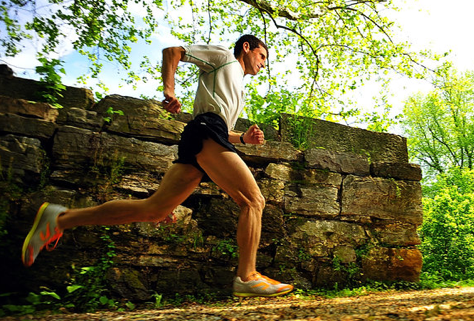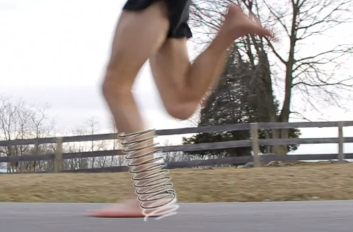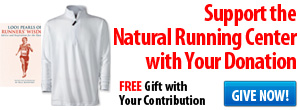In June 2013, the second Barefoot Connections conference was held in England, and most fittingly, it met inside the prestigious Natural History Museum which is located just outside London. Several leading practitioners and thought leaders in natural lifestyle and barefoot activity (walking and running) gave talks there. Family commitments kept me from making the trip across the ocean, but I presented a talk though Skype.
Here’s a copy of my talk “What I Have Learned From Barefoot and Minimalist Running”:
The writer James Joyce once said : “A man’s errors are his portals of discovery”. I have made almost all the errors in my life. I am a Family Physician who has been working in primary care clinics for 20 years. I entered this field of medicine since it seemed to be the area where one can have the most influence and impact on healthy lifestyles. I offer the prescription of daily exercise to every patient and ask them what activity they can do and like to do. A common reply is: “Well, I can’t run….”. My response is always “Tell me a little more about that.”
The conversation flows from “I have a bad back, knee, ankle” to “My last doctor told me to do something safer” to “it’s too difficult and painful” . My inquiry continues… “tell me some more about that.”
We are now at minute 14 of the traditional 15-minute patient visit, and this is not even the reason they came to see me. How much training did I get in medical school or residency specific to evaluating, preventing, and rehabilitating running injuries? The answer is near zero for me and most physicians and what we did learn was always based on treating a symptom and not the cause.
So I am here to tell you that you were designed to run and yes you can run. There is no pill invented for prevention of chronic disease. In certain high risk situations there are medications that reduce risk of future events, but true prevention is not allowing the condition to evolve. Diabetes and heart disease prevention? The evidence is strongest for the largest prevention being in the form of the daily walk or run and in what we eat.
The current minimal running movement is the confluence where doctors, podiatrists, health professionals, coaches, and runners are now joining and discovering the prevention prescription. I go back to a 1975 quote from Dr. George Sheehan: “If athletes were given less care and more thought, the doctors might come up with some original ideas on why illness persists, why injury doesn’t clear up. If more non-physicians– podiatrists and physiotherapists for instance–could be induced to lend their ideas and talents, we might see a completely new approach to sports medicine.”
My goal is simply to get folks outside, moving, enjoying their activity, and not be in pain. This has led to a number of developments in my own community of Shepherdstown, West Virginia, and which has involving hosting races and even my opening a small running store called Two Rivers Treads with a focus on teaching running form and minimalism.
 I have made a transition myself over the last 10 years after multiple injuries, foot surgery, and being told not to run. In my delving into the rabbit hole of running I have sought advice from the leading experts. Before recommending anything to others I try it myself. Six years ago I began cutting shoes down to a level drop, and gradually as my understanding of foot mechanics and kinetic chain evolved I started going into thinner and thinner shoes. Somehow through my store, writing, and competing I became one of the early leaders in “barefoot running” and was asked to present this topic with true experts Dr. Dan Lieberman and Dr. Irene Davis at the 2011 Boston Marathon.
I have made a transition myself over the last 10 years after multiple injuries, foot surgery, and being told not to run. In my delving into the rabbit hole of running I have sought advice from the leading experts. Before recommending anything to others I try it myself. Six years ago I began cutting shoes down to a level drop, and gradually as my understanding of foot mechanics and kinetic chain evolved I started going into thinner and thinner shoes. Somehow through my store, writing, and competing I became one of the early leaders in “barefoot running” and was asked to present this topic with true experts Dr. Dan Lieberman and Dr. Irene Davis at the 2011 Boston Marathon.
Dan and Irene were the research leaders in the field. I had been teaching running form, but in shoes. What could I learn from taking my shoes off? I set out to find out and made a gradual transition to running barefoot on grass and roads in the spring of 2011 before the Boston Marathon talk. We filmed and presented Barefoot Running Style showing the art and science of this. We followed this year with The Principles of Natural Running video on the components of proper running form.
I have reset many assumptions that most believe to be true about the risks of minimal and barefoot running:
• You land softer barefoot, especially on the hard roads. After a barefoot run where you must self regulate, there is less overall soreness. You experience discomfort and fatigue in the feet well before tissue breakdown (if of course you listen to the messengers- the feet). The day after running the 2011 Boston Marathon (a 2:34.00 at age 44) in a thin and flat shoe I had some of the usual post marathon soreness. I set out on a gentle barefoot run along the Charles River. After this run my body was reset. There was something magical about this that I could not fully explain.
• Your feet become thicker and softer. One does not develop hard callous, but rather a soft and thicker skin that is very resilient to surface irregularities. The road is the ultimate pumice stone as Dr. Irene Davis has said. The muscles of the foot thicken too. I cannot fit in any shoe I wore two years ago. My feet look like the hands of a lumberjack now and I have a large buffer to injury. My skin, muscles, bones, and tendons have become nearly bombproof.
• I have not cut my foot on needles or glass. Actually if I were to run over small pieces of glass or sharp rocks I am not worried. Like our primal ancestors who ran on rocks, the skin is tough and shapes around the object. A sharp hidden protruding object, that is a different story and I try to avoid these by doing most of my barefooting on the roads. This is where eyes come in. Tune in and watch for hazards.
• I have fixed form flaws. You cannot create friction running barefoot on pavement. It forces me to engage my glutes and get my foot down to the ground in the correct vector (accelerating backwards).
• There is more work in barefoot running, especially when the surface is not super smooth. For racing I can go faster and more reckless in thin shoes, but the barefoot teaches me the foot control, stability, form, and recoil that I can use better when I put a thin shoe back on.
• Muscles and tendons feel discomfort, joints do not. This is really important. A little soreness is a training effect as tissues get stronger. The worst running injuries are arthritis of major joints and these joints (big toe, knee, hip) are not wired for pain until extreme damage has occurred. So yes, everyone should fix their form and learn to land better even if one is not “hurt”.
 • I’m waking up my springs. Running is mostly elastic, and the more we are braced the smaller the springs become. I do supplemental drills to retrain this mechanism which was really strong as a rabid barefoot Ultimate Frisbee player in high school.
• I’m waking up my springs. Running is mostly elastic, and the more we are braced the smaller the springs become. I do supplemental drills to retrain this mechanism which was really strong as a rabid barefoot Ultimate Frisbee player in high school.
• The small but essential springs are the intrinsic foot muscles, peroneus longus/brevis, and posterior tib-essential for strength in toe off, balance, and proprioception (important especially in ankle stability). The large springs which are the Gastro/Soleus, Achilles, plantar fascia, and the long flexors of toes which stabilize the foot and recoil us off the ground. The small springs send important messages to the larger ones and should not be masked or made weak.
I have found a new enjoyment in running which comes from the sensations of the foot with the ground. My first running was barefoot on the beach and I am reconnecting with my inner child with a new sense of play when I run. The transition is patient and slow. Even after almost two years of barefooting I’m still adapting, and this is after almost 10 years of minimal shoes.


My feet have gotten too wide for almost any shoes since I began running in huaraches and barefoot. I wanted to love merrel vapor glove, but I was always stepping on the outside of the outsole and I feel uncomfortable in a lot of other shoes. This maybe the only downside of minimalist running 😛
very nice article
i’ve discovered a lot myself in the last 3 years i’ve been running strictly minimal
I was able to go straight to vibrams, taught myself to transition pretty smoothly without any injuries (not counting small insignificant blisters)
i’ve been running barefoot strictly for just over a year, helps when you’re not doing track…and at the time my soles weren’t ready for hurdling and sprinting on a tartan track lol
just wish my toes were in better shape :/
ah well, i’m doing awesome, did my first 5k barefoot back in march though i, of course, got sick the day of so i couldn’t run as fast but my goal was to finish
it was a brutal course let alone being sick lol
i’ve coached and converted many of my friends and others with no problems
it’s amazing what i’ve been able to change after switching
Great article,
I live in The Netherlands and over here there are not manny barefootstyle runners or even sporters. During al my sportactivities I try to get as close as I can get to barefootstyle. It’s quite interesting to see how you can use barefootstyle at aerobic types of small group training. Or during adventure races. At my daily work as a military sportinstructor and personal trainer I try to coach my clients towards barefootstyle. And this works, even so good that I started my own barefootstore in The Netherlands. But there is one problem, there are not enough barefootstyle sporters at this moment to stop my instructors activities and go all the way with barefootstyle.
At this moment I am experimenting with multiple sport adventure races. Like a total of 100 km race starter with 15 km kickbike, 10 km canoe, 15 running and 35 km cycling. Al barefootstyle om mij VFF. Normaly I should use a trail salamon running shoe, now days I am using my VFF or Huarache “Trail”.
After a race my feet are tired, yes of course, but the day after the are recovered and ready to go again. Only that should be a reason to go barefootstyle.
Keep up doing the studies an stay posting. There I a whole world to inform.
Greetings Pepijn
I converted to minimal (huarachis and zero drop trail shoes) 18 months ago. It has been a rediscovery of running – I’ve been running since 1967 when I started high school. I’ve learned that the body is a complete system and, as with any system, you can not just change one thing. Moving to minimal shoes led to foot muscle adaptation, then achilles muscles and cal muscles. I have a little hip issue going on now. I will say that I do not feel the joint pounding, impact related pain that I used to after long runs in technical shoes. My muscles get tired and I feel the workout, but my joints (outside of the recent hip thing) all feel good. I have done a marathon and two half marathons (one yesterday) in minimal footwear. I periodically run short distances barefoot to reinform my form.
Thanks for your posts and insights. They are well reasoned and balanced.
jlg
I ran a marathon on June 22nd. I went for a five and a half mile run in Five Fingers the next day. I’ve run 3 marathons in the last 3 months. I take few days off, mainly just the day before races. I started researching natural running almost a year ago, and in that time have obviously improved tremendously and am not injured. I wasn’t much of an athlete before I started running in the barefoot style, and am still not now, yet I do fairly well in my races, and place pretty well in my age group. It’s puzzles me that most recreational runners persist in an inefficient, difficult style of running. I don’t like working harder than I have to and being in pain. I enjoy having fun.
After switching to minimalist shoes, I have actually improved on my endurance and I find I can run longer than usual. I get on to the 0mm drop barefoot shoes every now and then but mostly work out in my 2mm drop shoes.
There has been so much debate about barefoot shoes causing injury, but I think if the runner watches closely to their body posture, cadence and foot landing, these shoes are actually much better than traditional cushioned shoes.
Excellent story! We need more of YOU out there in the world. I ran my first marathon in May and did it wearing some very well worn Vibram Five Fingers. I had wanted to wear my xeroshoes (huaraches), but in the end decided to go with what I had put the most miles on.
Really, without any doubt, our bodies are our best teachers. Sadly, there aren’t enough “professionals” out there to spread the word. Thank you for your dedication!
Great read, I look forward to seeing if and how barefoot running and perhaps more importantly the science surrounding the movement continues to develop over the next decade or so. I’d be interested to know your thoughts on if you truly think barefoot running is for everyone and if so, why?
Can any of you guys frequently barefoot make any suggestions about how you care for the sides of your feet. The bottoms stay tough from use, the sides can get cracked from grass, sticks etc & in winter they tend to get worse form less humidity.
Thank you
John a good pumice stone and some foot cream will help you shed the dead and callous skin. or get a pedicure 🙂 Mark